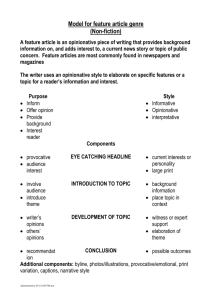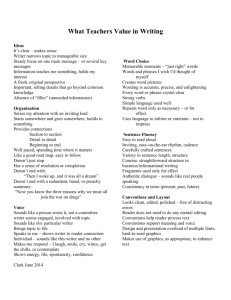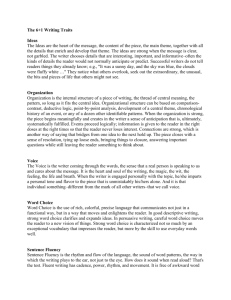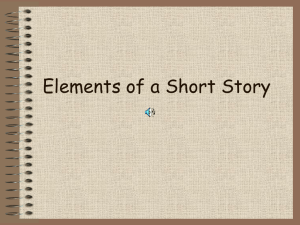English IV Advanced Placement
advertisement
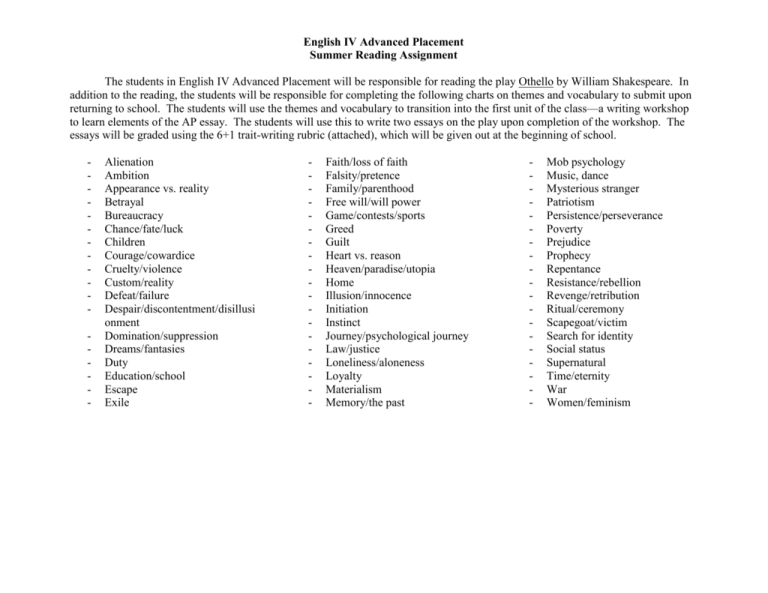
English IV Advanced Placement Summer Reading Assignment The students in English IV Advanced Placement will be responsible for reading the play Othello by William Shakespeare. In addition to the reading, the students will be responsible for completing the following charts on themes and vocabulary to submit upon returning to school. The students will use the themes and vocabulary to transition into the first unit of the class—a writing workshop to learn elements of the AP essay. The students will use this to write two essays on the play upon completion of the workshop. The essays will be graded using the 6+1 trait-writing rubric (attached), which will be given out at the beginning of school. - Alienation Ambition Appearance vs. reality Betrayal Bureaucracy Chance/fate/luck Children Courage/cowardice Cruelty/violence Custom/reality Defeat/failure Despair/discontentment/disillusi onment Domination/suppression Dreams/fantasies Duty Education/school Escape Exile - Faith/loss of faith Falsity/pretence Family/parenthood Free will/will power Game/contests/sports Greed Guilt Heart vs. reason Heaven/paradise/utopia Home Illusion/innocence Initiation Instinct Journey/psychological journey Law/justice Loneliness/aloneness Loyalty Materialism Memory/the past - Mob psychology Music, dance Mysterious stranger Patriotism Persistence/perseverance Poverty Prejudice Prophecy Repentance Resistance/rebellion Revenge/retribution Ritual/ceremony Scapegoat/victim Search for identity Social status Supernatural Time/eternity War Women/feminism Theme Chosen Othello is about ______. EXAMPLE: Alienation First evidence of theme from play (specific act, scene, and lines that exemplify this theme) Second evidence Third evidence What does this theme SHOW/TELL us about life in general? Othello shows that __________. When our intense desire for the company of others goes unfulfilled, the consequences can be tragic. Word Allegory Alliteration Allusion Anachronism Anecdote Anthropomorphism Antihero Apostrophe Aside Assonance Ballad Bathos, Pathos Black humor Cadence Canto Catharsis Chorus Colloquialism Conceit, Controlling Image Connotation Denotation Definition Use in original sentence (you may change part of speech) OR Found example from literature Consonance Couplet Diction Syntax Irony (and types) Elegy Enjambment Epic Epitaph Farce Foil Free verse Gothic, Gothic novel Hubris Hyperbole Implicit In medias res Irony Metaphor Simile Metaphysical conceit Metonymy Objectivity Subjectivity Omniscient narrator Oxymoron Parable Paradox Parallelism Parody Personification Point of view (and types) Protagonist/Antagonist Pun Rhetorical question Satire Soliloquy Stock characters Stream of consciousness Subjunctive mood Suspension of disbelief Theme Tragic flaw Utopia/Dystopia 6+1 Trait-Writing Rubric 5 3 1 Ideas This paper is clear and focused. It holds the reader's attention. Relevant details and quotes enrich the central theme. The writer is beginning to define the topic, even though development is still basic or general. As yet, the paper has no clear sense of purpose or central theme. To extract meaning from the text, the reader must make inferences based on sketchy or missing details. Organization The organization enhances and showcases the central idea or theme. The order, structure, or presentation of information is compelling and moves the reader through the text. The organizational structure is strong enough to move the reader through the text without too much confusion. The writing lacks a clear sense of direction. Ideas, details, or events seem strung together in a loose or random fashion; there is no identifiable internal structure. Voice The writer speaks directly to the reader in a way that is individual, compelling, and engaging. The writer crafts the writing with an awareness and respect for the audience and the purpose for writing. The writer seems sincere but not fully engaged or involved. The result is pleasant or even personable, but not compelling. The writer seems indifferent, uninvolved, or distanced from the topic and/or the audience. Word Choice Words convey the intended message in a precise, interesting, and natural way. The words are powerful and engaging. The language is functional, even if it The writer struggles with a limited lacks much energy. It is easy to figure out vocabulary, searching for words the writer's meaning on a general level. to convey meaning. Sentence Fluency The writing has an easy flow, rhythm, and cadence. Sentences are well built, with strong and varied structure that invites expressive oral reading. The text hums along with a steady beat, but tends to be more pleasant or businesslike than musical, more mechanical than fluid. The reader has to practice quite a bit in order to give this paper a fair interpretive reading. Conventions The writer demonstrates a good grasp of standard writing conventions (e.g., spelling, punctuation, capitalization, grammar, usage, paragraphing) and uses conventions effectively to enhance readability. Errors tend to be so few that just minor touchups would get this piece ready to publish. The writer shows reasonable control over a limited range of standard writing conventions. Conventions are sometimes handled well and enhance readability; at other times, errors are distracting and impair readability. Errors in spelling, punctuation, capitalization, usage, and grammar and/or paragraphing repeatedly distract the reader and make the text difficult to read. Presentation The form and presentation of the text enhances the ability for the reader to understand and connect with the message. It is pleasing to the eye. The writer's message is understandable in this format. The reader receives a garbled message due to problems relating to the presentation of the text.

